Menu
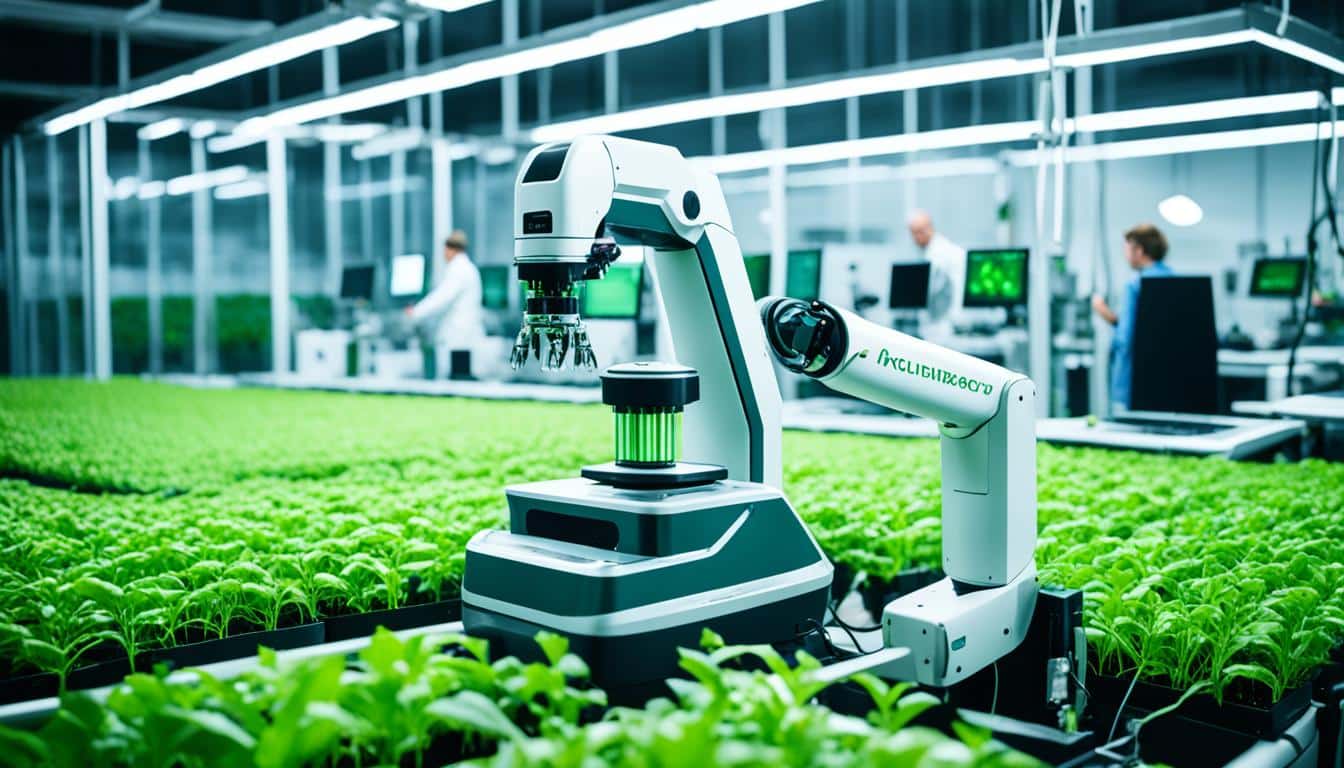
Did you know that in 2012, a staggering 88% of corn, 94% of cotton, and 93% of soybeans planted in the United States were from biotechnology? These figures show how much the field has grown. This tech has made farming more productive, sustainable, and efficient. It uses genetic engineering to change plants and animals for better agricultural use. Because of this, we see more crops and livestock, helping agriculture to last longer.
Biotechnology in agriculture has changed farming a lot. It brings new technology to the field. This includes improving efficiency and making crops that resist pests and weed killers. For example, in 2012 over 88% of corn, 94% of cotton, and 93% of soybeans in the U.S. were biotech crops. This shows how important and common biotechnology is in farming now.
To change plants and animals, biotechnology uses many methods. It looks at bacteria like Listeria to make food safer. It also makes crops healthier through gene editing. This makes plants better at handling dry spells and bugs. It helps farms produce more food. Genetically changed crops also help control weeds with farm-safe chemicals. This protects the ground’s top layer.
Biotechnology helps cut down on using strong chemicals to kill pests. This means less risk to water and safer ways to control insects and weeds. All these changes mean more and better food can be grown. This is good news for farmers. It makes their job easier and gives them more time for other things.
| Crop | Percentage of Biotechnology Plantings (2012) |
|---|---|
| Corn | 88% |
| Cotton | 94% |
| Soybean | 93% |
In animal farming, biotechnology helps make antibiotics and vaccines. It’s a new field, just 30 years old, with a lot of room to grow. But checking the safety of these changes is very important. This includes making sure the land and food are safe from harm. This way, we can enjoy the benefits of biotechnology without worry.
Agricultural biotechnology goes way back, thousands of years ago. It all began with farmers selecting the best plants and animals. They did this to improve key features of these species. This made them more useful and easier to handle. Later, the use of microorganisms in making food added a new chapter to this story. This journey from ancient times to now shows how farming evolved through the years.
The start of agricultural biotech can be traced to early farming. Farmers chose and bred plants and animals for better traits. With time, these wild species became domesticated and more useful. Then came radiation mutagenesis, pushing crop modification even further. Thanks to this method, we have over 2,500 types of plants, like rice and lettuce.
Important discoveries in genetics also played a big role. Barbara McLintock’s work in 1950 showed how maize colour changed with transposons. Then, in 1953, Watson and Crick found out about DNA structure. Both these discoveries changed the game for genetic research. They connected the old breeding ways to the new field of genetic engineering.
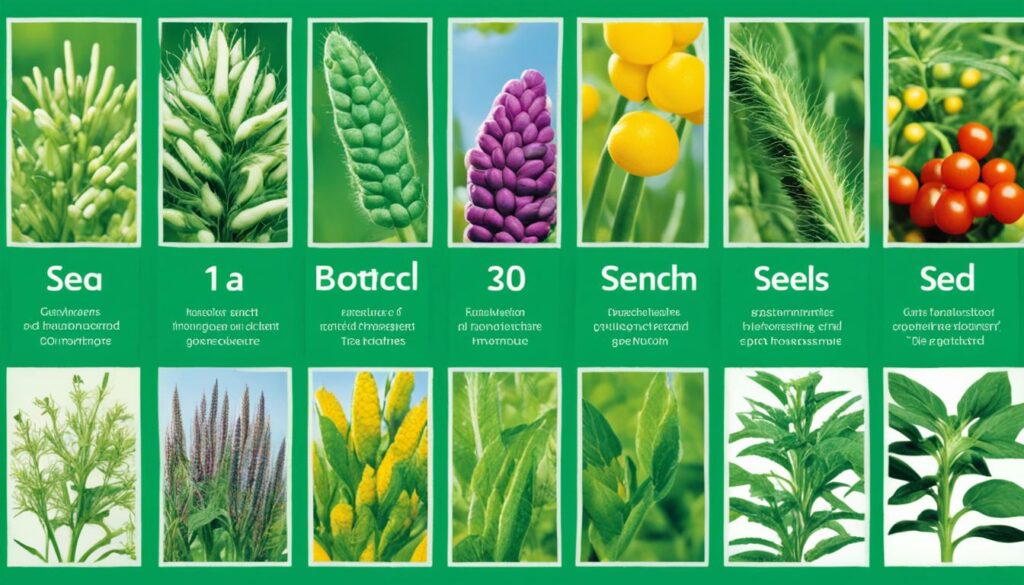
Early on, different cultures used fermentation for food. The Egyptians made leavened bread with yeasts. The Chinese used it for brewing and making cheese. The Aztecs even made nutritious cakes from Spirulina algae.
Fermentation was one of the first biotech processes in food making. It not only kept food fresh but also made it tastier and more nutritious. This shows the deep link between microbial activity and biotech in agriculture. The techniques from those ancient times still impact farming innovations today.
Advanced genetic engineering is changing agriculture. It’s driving big improvements in farming.
Gene editing is transforming how we farm. CRISPR-Cas9 lets scientists change crop genes precisely. This improves crops, making them yield more and resist pests better.
Today, genetic engineering is key to better farming. Scientists use viruses and other tools to move genes between species.
For example, we now have cotton that bugs won’t eat. This means we use fewer harmful chemicals. Scientists are also making potatoes and other veggies better at fighting off diseases.
Fermentation by microbes is very important in farming technology. It gives us antibiotics and healthy plant products. This way of farming is more sustainable and the plants are better.
With this, we use less harmful stuff like pesticides and save water. Microbes are helping make farming better. They even add new genes to plants, making them stronger against diseases.
The story of genetically modified crops is filled with key moments. To get into this topic, we need to look at how these crops started. In 1990, China made a big step with GM tobacco that could fight off TMV. Then, the USA allowed the eating of GM crops by okaying the Flavr Savr tomato in 1994.
Genetic modification brought a huge change, much like the Green Revolution did. It means altering a plant’s genes for certain benefits. Now, we can make plants better without adding new genes. This is a new way since early GM plant approvals.
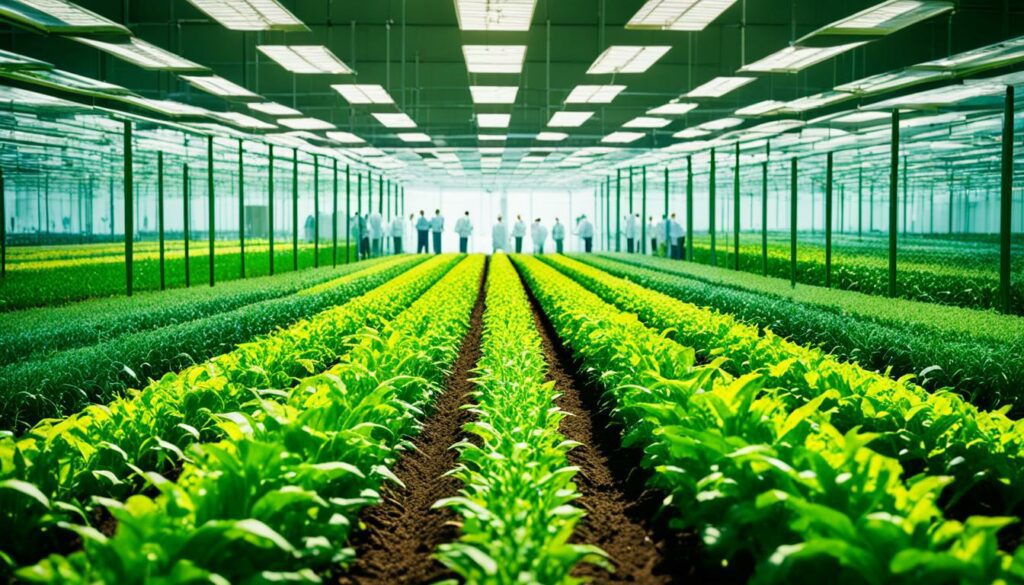
Today, we see GM crops in many cereals, fruits, and veggies like rice and strawberries. By 2012, most corn, cotton, and soybeans in the US were genetically modified. This shows how popular and useful GMOs are.
GM crops have many pluses. Insect-resistant cotton means we use fewer pesticides. Plants that tolerate herbicides help control weeds without harming nature or people. GM papayas saved the US industry from a deadly virus, proving how GM tech can protect our food.
Research is working to make crops healthier, more disease-proof, and better yielding. The USDA, EPA, and FDA all work to check GM foods for safety. They make sure GM crops don’t hurt us or the environment.
GM tech has led to big benefits — cutting pesticide use by 37%, upping yields by 22%, and lifting farmers’ money by 68%. These wins, especially big in poorer countries, show how crucial GM crops are for farming. Studies say crops that resist bugs do better than those that fight weeds, benefiting farming and finance.
Modern farming depends heavily on controlling pests and weeds. Thanks to biotechnology, methods for managing these issues have improved. This is seen in crops that resist insects and tolerate herbicides well. The goal is to use less synthetic pesticides, which is good for the planet and profits of farmers.
Insect-resistant crops have changed how we deal with bugs in farming. They contain genes that fend off insects, reducing the need for chemicals. Less need for insecticides means fewer crops are lost to bugs. For instance, 93% of soybeans grown in the U.S. in 2012 had this protection. This makes managing pests easier and greener.
Some crops are also designed to handle herbicides. This makes weed control simpler and more efficient. Without hurting the crop, specific herbicides are used to kill the weeds. In 2016, 84% of U.S. corn fields used these special crops. They are key to keeping farms productive with less hard work, like pulling weeds by hand.
| Crop Type | Biotech Plantings (2012) | Percentage of Total Plantings |
|---|---|---|
| Corn | 88% | 91% of farms |
| Cotton | 94% | 94% of plantings |
| Soybean | 93% | 93% of plantings |
Genetically engineered crops bring big benefits to farming that cares for the earth. By using less chemical and keeping the soil healthy, these methods are very eco-friendly. The USDA, EPA, and FDA make sure these crops are safe for us and the planet before farmers can use them.
Today, agricultural resilience technologies are advancing fast. They make crops stronger against bad weather and other tough conditions. These biotech solutions help make stress-resistant crops.

In the 1970s, the Southern Corn Leaf Blight hit hard. This disaster showed us we needed tougher crops. Since then, we’ve used modern biotechnology to make crops stronger. It’s like how different types of food today keep us safe from shortages.
Back then, we realised our major crops were too vulnerable. So, we started focusing on biotech for crop resilience. Now, we have crops that can fight off bugs, handle not enough water and salty soil. Countries like the US, Argentina and Brazil are growing these tough crops already.
We’ve done a lot to make crops tough through genetic engineering. Look at South Africa. Their GM maize helps a lot more people eat better. This shows why tough crops are key.
From the 1960s to 2000, biotechnology helped start a big change in farming. The way farmers in Asia started growing new rice back in 1983 is a huge example. It shows how these new farming methods can spread fast.
In 2021, we’ve gone back to old, forgotten crops in Asia to fight long-term hunger. Also, Africa is working on making rare healthy crops part of normal farming. These steps show the world knows how much we need biotechnology in farming.
Here’s how different places are using biotech to grow better crops:
| Region | Crop Type | Biotechnological Advancement | Impact Stats |
|---|---|---|---|
| USA | Corn | Drought Tolerance | Significant Yield Gains |
| South Africa | Maize | Genetically Engineered Varieties | Larger Yields for Human Consumption |
| Argentina, Brazil | Wheat | Drought Tolerance | Approved and Adopted |
| Bangladesh | Bt Brinjal | Genetic Mutation | Improved Market Value |
| Philippines | Golden Rice | Pro-vitamin A Enhancement | Mass Production Commenced |
It’s obvious. We need agricultural resilience technologies to grow crops that can handle tough times. Using biotech for crop resilience is making our farms better. It makes farming more secure and productive.
Using genetic engineering in farming has changed how we make food that’s good for us. Now, we can boost nutrients in crops and lower their allergy risks. This has made a big difference.
Golden Rice is a key success story. It’s rice with extra beta-carotene that helps make vitamin A. This is vital for fighting eye problems and death in kids with vitamin A shortages.
By adding these nutrients, agricultural genetic engineering fights malnutrition globally.
Today, we also have crops with fewer allergens. Scientists use fine editing to make foods like peanuts and wheat safer for many. This means less risk for those with food allergies.
Agricultural genetic engineering tries not only to make food more nutritious. It also aims to keep it safe for everyone.
Let’s look at the U.S. in 2012. Nearly all of the corn and soybean fields used biotechnology. This shows how much farmers trust these methods to grow lots of good food in a smart way.
Globally, these crops are also performing better than before. They give more, are of higher quality, and can withstand more types of stress. This is all thanks to genetic tweaks that speed up plant improvement. This quick process is key to meeting the food needs of more and more people worldwide.
Agricultural biotechnology is key to keeping farming sustainable. It has led to less pesticide use. In 2012, a large part of US crops like corn, cotton, and soybeans were biotech. This cut down on using harmful chemicals.
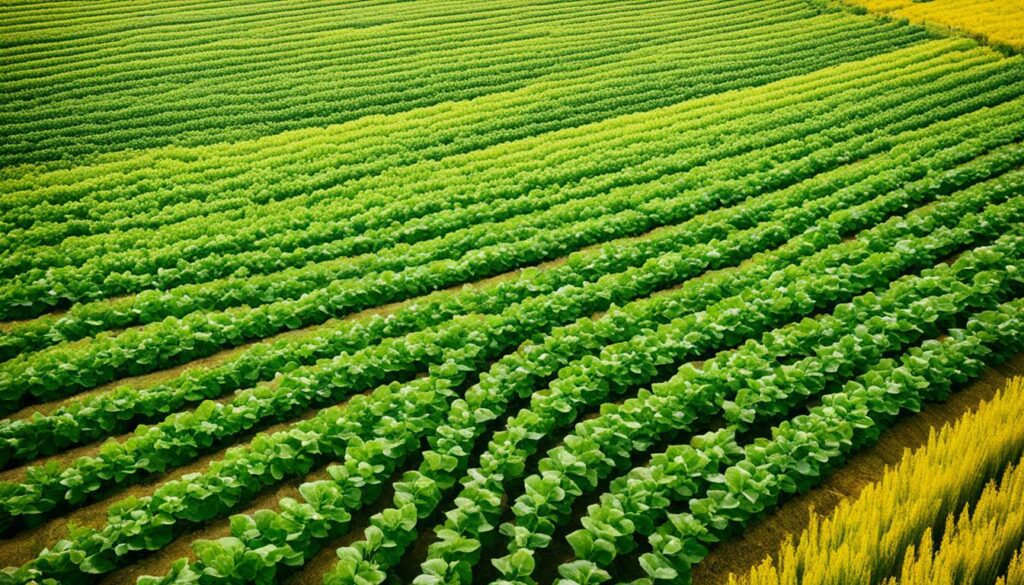
In eco-friendly farming practices, biotechnology supports no-till farming. This method keeps the soil strong, stops erosion, and helps water stay longer. Also, biotech environmental impact has plants that clean polluted soil. These special plants remove toxins, making the land safe again.
Agricultural biotechnology also makes crops tougher against tough conditions. Some crops can survive in dry or salty lands. This means food can grow in places where it was hard before. It stops farms from using too much new land, which cuts down on cutting forests and losing animal homes.
The tools of agricultural biotechnology sustainability help study genes better. Experts understand bacteria and tiny organisms more. This lets them make farming that’s better for nature.
Government checks by the USDA, EPA, and FDA keep biotech products safe. These checks look closely at the risks. They make sure the technology is safe for nature and people. This way, new agricultural techniques can keep being used safely.
Plant breeding technology has changed a lot with biotechnology’s recent progress. This rapid breeding advancements is changing how we deal with farming issues. It speeds up creating new plant types with wanted qualities.
A big benefit is that we’re making plants faster than before. Techniques like picking the best genes help cut down mistakes when making changes. This means better kinds of plants can be made quicker. For example, quick neutron-controlled changes help crops resist diseases and produce more, seen in rice and soybeans.
New tech allows us to pick and change plant traits very carefully. Things like CRISPR/Cas9 are used to tweak plant genes exactly as needed. This leads to better crops. They can produce more food, be more nutritious, and handle tough conditions better. By being very careful with these changes, plants get exactly the changes we want. This lines up with what precision farming aims for.
Improving breeding shows a key step in farming better and keeping it going. By working on rapid breeding advancements, we’re aiming for crops that are efficient and can cope well with any situation in the future.
Biotechnology is key to ensuring there’s enough food worldwide. It tackles issues the agriculture sector faces. With biotech, we can meet the growing need for food better. Genetically modified crops have lifted yields and made crops better. In 2012, most plantings of corn, cotton, and soybeans in the US were biotechnologically improved.
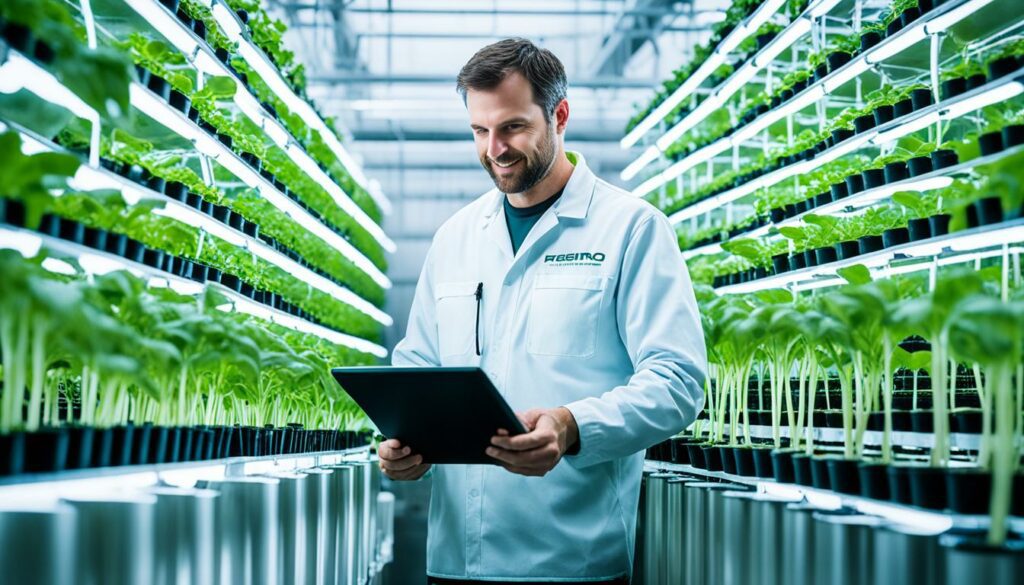
The world’s population is growing, putting more stress on our food supplies. Biotechnology improves how much food we can get from crops. It makes plants more resistant to pests and diseases. This means we don’t need as many chemical pesticides.
Crops are also made to handle tough conditions like drought and salty soil. This makes them stronger and more reliable.
In poorer countries, biotechnology can make a huge difference. By growing new kinds of crops, farmers can get more food with less work. The ISAAA helps spread biotechnology in these areas. It aims to make food more secure everywhere.
Creating nutrition-rich crops is another goal. For example, adding more beta-carotene to rice can help fight malnutrition. This makes food safer and more available, especially in places that need it most.
| Biotech Crop | Percentage of Total Plantings (USA, 2012) |
|---|---|
| Corn | 88% |
| Cotton | 94% |
| Soybeans | 93% |
Phytoremediation is a key biotechnological method using special plants to clean up soil. It removes harmful substances from the ground. This keeps farming safe and our environment healthy. It works best on large areas with small amounts of pollution.
There are five main ways plants clean the soil in phytoremediation. Each one is good for different types of pollution. This method is great because it makes very little extra mess. Plus, the ground is still good to use after treatment. But, it can take a long time, and not all pollutants can be removed fully.
A recent study shows how well phytoremediation can work, especially with metals. In Nepal, another study found it made a big difference in cleaning up heavy metals. This shows phytoremediation is really important for making bad soils and waters clean again.
Using phytoremediation in farming is a big step for the environment. As we learn more, this method will likely get even better. It can help more areas and do more good for the earth.
In the last years, *animal biotech in agriculture* has made big steps. It focuses on creating vaccines and making animal feed better. This has led to significant improvements in agriculture’s productivity and its impact on the environment.
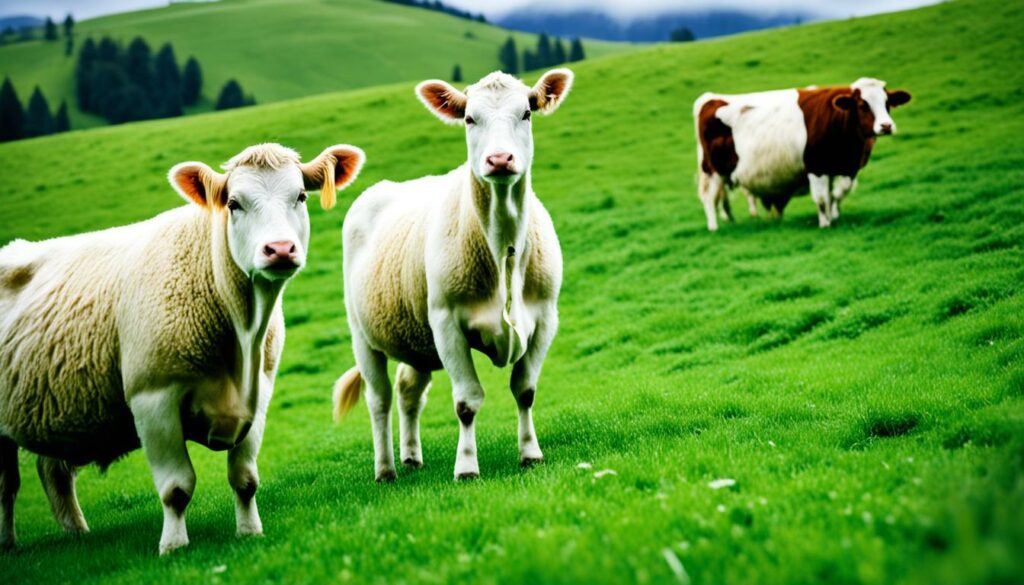
*Genetic engineering for animal health* is key in making vaccines. For example, vaccines for foot and mouth disease have been made using genetic engineering. These vaccines cut down on outbreaks, protecting animals and the money they bring.
The better vaccines not only protect more but also cost less to make.
*Biotech in livestock nutrition* has boosted how well animals use their food. By changing the genes in feed, scientists have made food get absorbed better. This means animals are healthier and produce more, while wasting less food.
This makes farming more sustainable by meeting the animals’ specific food needs and cutting down on waste.
Below is a table that looks at how genetically engineered animal vaccines and enriched feeds help:
| Aspect | Genetically Engineered Vaccines | Nutrient-Enriched Feeds |
|---|---|---|
| Primary Benefit | Reduction in Disease Outbreaks | Improved Nutrient Absorption |
| Cost Efficiency | Lower Production Costs | Reduced Feed Waste |
| Environmental Impact | Less Use of Synthetic Pharmaceuticals | More Sustainable Farming Practices |
So, using *animal biotech in agriculture* is crucial. It makes animals healthier and food more efficient. This then leads to a stronger and greener farming.
More than ever, we need to farm sustainably. This means making profits, caring for the Earth, and thinking about people. Sustainable agriculture is crucial to feed 9 billion by 2030 and fight climate change.
In the United States, biotechnology is a key part of sustainable farming. In 2012, biotech crops were a big deal. They were in 88% of corn, 94% of cotton, and 93% of soybeans. This shows how biotechnology helps crops grow better and need fewer chemicals.
Sustainable farming means doing things that are good for the land and the economy. During the 21st century, farming saw big improvements. Thanks to better management and technology, crops like maize and soybean are doing better. But, we still need to do more to meet the world’s food needs.
One big way biotechnology helps is by making soil healthier. It uses tiny organisms to help plants grow and fight diseases. This makes farmland better and more able to produce food.
For farming to last, it must also help people and protect the planet. Biotech can make farming more profitable and fair. It can grow better crops without harming the environment. This way, we save the Earth and use its resources well.
| Crop | Yield Increase Per Year | Biotech Adoption Rate (2012) |
|---|---|---|
| Maize | 1.6% | 88% |
| Rice | 1.0% | Unknown |
| Wheat | 0.9% | Unknown |
| Soybean | 1.3% | 93% |
Biotechnology is a game-changer for sustainable farming. It helps produce better crops and use nutrients wisely. This makes the future of farming bright when we use biotech smartly.
Agricultural biotechnology plays a key role in facing climate change. It brings us drought-resistant and saline-tolerant crops. These crops help fight the impact of climate change on farming.
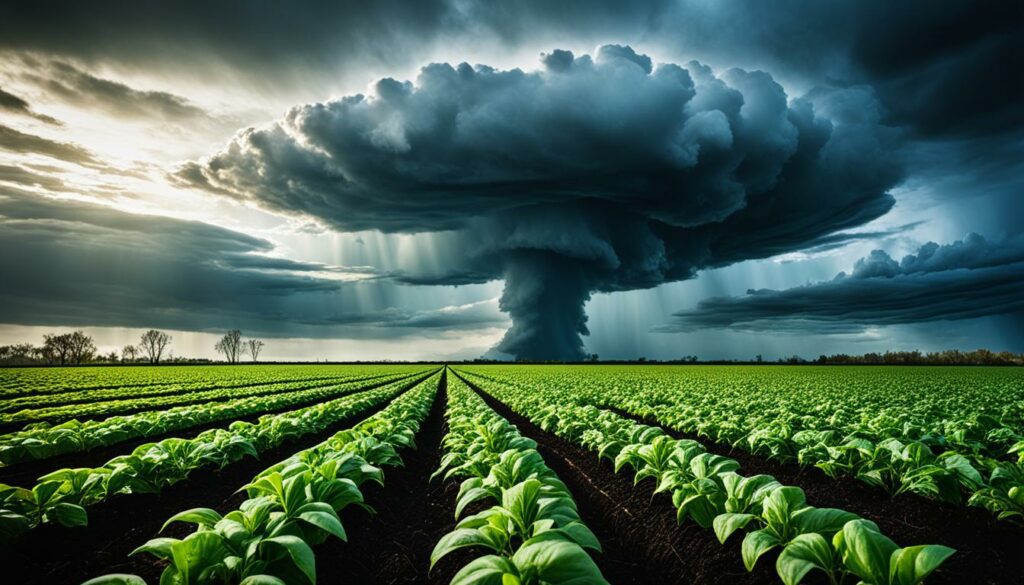
Agricultural biotechnology has led to drought-resistant crops. For example, there’s now drought-tolerant wheat in Argentina and Brazil, and corn in the U.S. These crops help keep food supplies stable despite changing weather caused by climate change. Besides wheat and corn, they also improve other vital crops’ resistance to drought.
With sea levels rising, soil salinity is a big issue for food production. Thanks to genetic engineering, we now have crops that can grow in salty conditions. This is especially important in areas where usual crops can’t grow well anymore due to salt. Using these crops in farming helps us keep growing food, even in tough environments.
Climate change makes biotech crops more critical than ever. The U.S. stands out in using agricultural research to tackle climate challenges. With better crop resilience and farming techniques, these biotech solutions head off climate impact. They also set the path for more sustainable and productive food systems in the future.
The future of agricultural biotechnology is very promising. Current uses show just how impactful it is. For example, in 2012, the majority of key crops in the US were genetically modified. This shows the fast growth of trends in biotech farming.
USDA’s National Agricultural Statistics Service looked into this. They found that biotech crops are now the norm for many farmers. This change is a big step forward, all supported by the International Service for the Acquisition of Agri-biotech Applications (ISAAA).
Mutation breeding, a key method, improved over 3,000 crop types. It made basics like rice, barley, and wheat better and stronger. Hybrid technologies are also impactful. For example, in the US, using hybrid corn started showing big increases from 1947. These gains kept growing, reaching high yields in 2012.
In China, hybrid rice took off, breaking records with high productivity. This highlights how important biotech innovations are. India is also focusing on hybrid rice to enhance food security using biotech.
Yet, a really exciting future bit is using advanced techniques to extract valuable compounds from plants. This includes polyphenols, using ways like pulsed electric fields. These methods can make food products healthier.
Overall, making crops better and more nutritious is key with biotech. This paves the way for a future where farming is smarter and less reliant on nature.
The journey through agricultural biotechnology has been amazing. This field is only 30 years old but full of big changes. There are now over 17,000 types of crops and we have crops that can resist bugs and weed killers. This lets farmers be more sustainable and cuts down on harmful pesticides.
Golden Rice and GM papaya in Hawaii show how powerful this technology can be. They help fight against malnutrition and save an industry. Click here to learn more about the progress in agricultural biotechnology.
The UNEPGEF Framework is now used by 126 countries. It shows our shared goal for safety and better practices in biotechnology. But in places like India, there are challenges. Political and scientific debates slow down the use of new technologies.
Even with these issues, biotechnology can do a lot of good. It can make our food safer, and the way we farm better for the planet. We must work together to keep making progress while dealing with the hard parts of this field.
Agricultural biotechnology is about using tools to change living things for farming. It uses methods like genetic engineering. This makes crops and animals better for farming more sustainably.
Biotechnology makes farming better in many ways. It creates crops that can resist pests and weeds. This means fewer chemicals and less effort in managing the fields. It also boosts the nutrition of crops, making food more healthy and plentiful.
The story of agricultural biotechnology goes back over 10,000 years. It started with selecting the best plants and animals for breeding. Using microorganisms in food also helped to enhance crops and make better food.
Today, we have many advanced methods. These include editing genes, genetic engineering, and using microbes. They allow us to change organisms at the gene level. This makes better crops and medicine.
GM crops are plants with changed genes. They can have traits like pest resistance. These crops are popular because they protect themselves. This lowers the need for pesticides and increases yield.
For pests and weeds, there are special crops. They resist insects or weed killers. This innovation cuts down on harmful chemicals in the environment. It also makes managing pests and weeds easier.
Biotechnology makes crops tougher. They can survive tough conditions like drought. This helps farmers grow food in places that were hard before.
Genetic engineering boosts crop nutrients. For example, it can increase beta-carotene in rice. It also lowers food allergens. This means healthier food.
There are many benefits. Less pesticide is used. It works well with eco-friendly farming. And, it helps clean soil from toxins. This all supports a greener, healthier planet.
Now, plant breeding is faster and more exact. This gives us crops with the best traits. They help feed more people and improve farming.
Biotechnology is key for secure food supplies. It raises crop yields and quality. This is big help especially in developing nations. It makes food more available and healthy.
Phytoremediation uses plants to clean the soil. It removes pollution, supporting farming and the environment alike.
Animal biotechnology helps by making vaccines and improving feed. This leads to healthier livestock that produce more. It’s a win for farmers and food supply.
It lowers harmful run-offs and saves habitats. It helps in growing tougher crops. And it makes animal farming more efficient. All of this is good for the long-term health of farming.
It tackles climate change by creating crops that cope better with tough conditions. These crops need less water and can grow in salty soils. They protect farming from climate harm.
Now and in the future, we’ll see more plant-based medicine and crops that use less. This shows how biotechnology continues to improve, giving us sustainable farming.